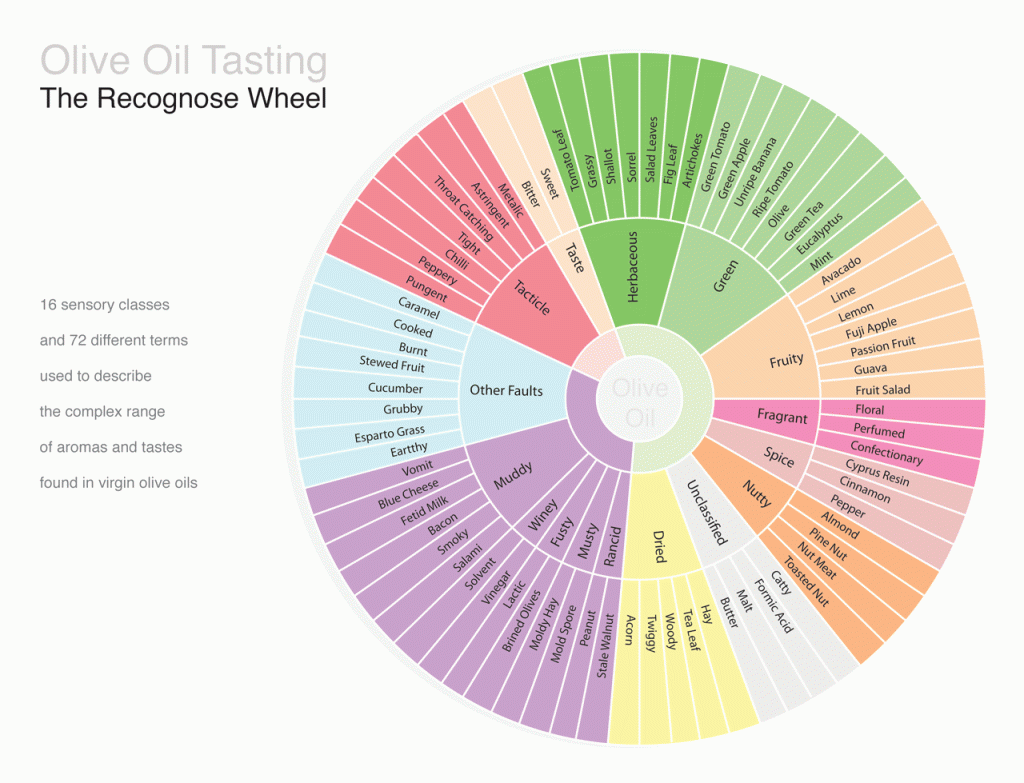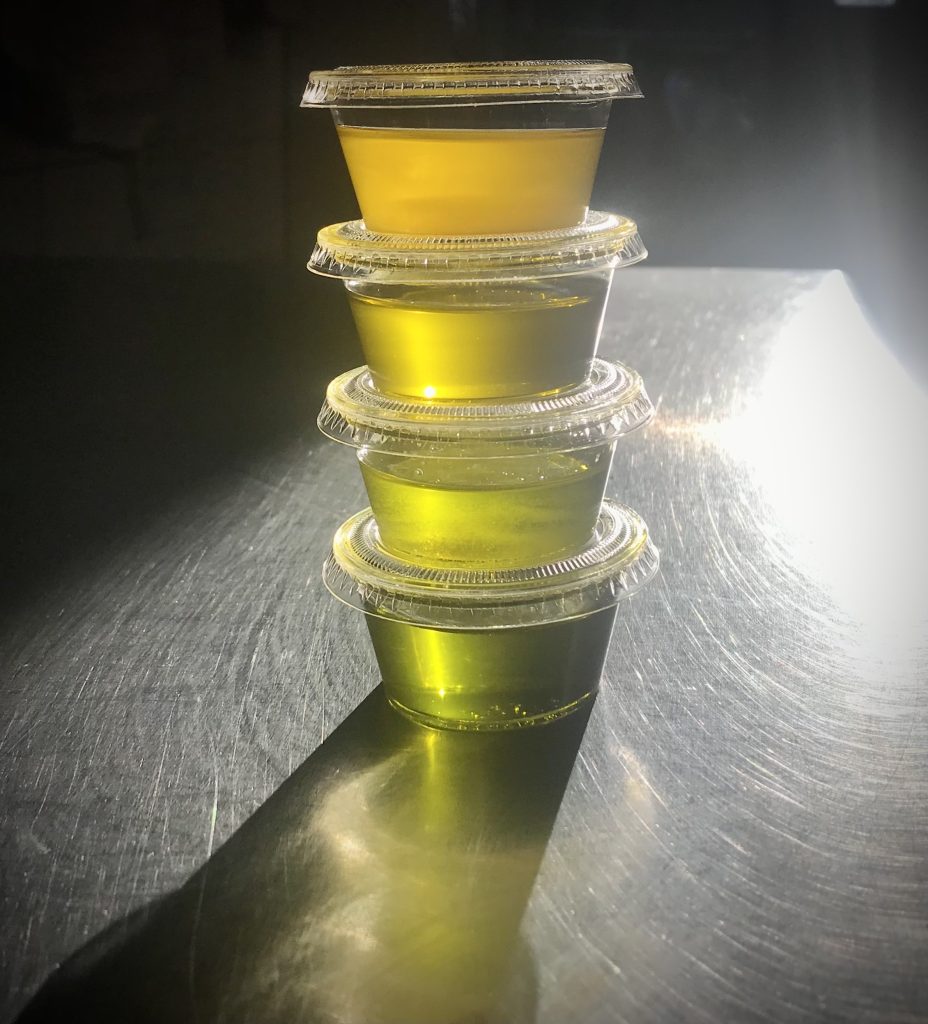Why olive oils can taste so different
There’s a lot to know about olive oils, but you don’t have to be an expert to be able to find a bottle you enjoy. We’ve talked about how to read and understand olive oil labels and now we’re covering the basics of how to understand the spectrum of olive oil flavor profiles. We’ll introduce you to four common flavor categories for olive oil, three major factors that can affect olive oil flavors, and how to recognize olive oil defects.
Common Olive Oil Flavor Profiles
We’re breaking down olive oil flavors into three, broad flavor categories: Spicy/Assertive, Grassy/Bitter and Fruity/Floral. It’s a helpful way to categorize olive oils, as well as narrow down what you might be looking for, but it isn’t perfectly clear cut and narrowly defined, some oils neatly fit in one category, while others might overlap across a couple of categories. So think of this as a guide rather than a definitive ruling.
Spicy/Assertive
These oils are smooth, but emphatic, with assertive flavors that might be described as fruity, green, and/or peppery; they’re wonderful drizzled on pasta, soups, and stews.
Examples include Podere Forte and Goutis Estate Sea Breeze
Grassy/Bitter
These are the oils that produce a tight, mouthwatering punch, with distinctive, deep, earthy, and grassy flavors; pair these with bitter greens, red meats, or artisan breads.
Examples include Elvira Loamie and Marqués de Valdueza
Fruity/Floral
These oils are delicate and sweet; they tend to be great on salads, vegetables, and grilled chicken.
Examples include Alziari and Maussane

The Factors that Impact Olive Oil Flavor
Olive oil lives on our shelves in bottles; since we get it in its final form, the oil, we don’t always think about it as an agricultural product, but it is! Which means, a number of different factors impact the flavor of the olives, and in turn, the flavor of the finished product. Ari Weinzweig, one of the founders of Zingerman’s, talks about a number of factors that distinguish one oil’s flavor from the next in his book, Zingerman’s Guide to Good Eating: How to choose the best bread, cheeses, olive oil, pasta, chocolate, and much more (Houghton Mifflin, 2003), three of which we’re highlighting here.
Varietal Differences
Just like you might reach for a Fuji apple for snacking and reserve Granny Smith apples for baking, different olive varieties have different flavor profiles, too. They might not be as well-known as apple cultivars, but there are still dozens of different varieties. In Italy alone, Ari writes, there are more than three dozen types of olives grown for oil, “including Taggiasca in Liguria; Frantoio, Moraiola, and Leccino in Tuscany; Coratina in Puglia; and on Sicily, the one with my favorite olive name, Giraffa.” Some producers work with a single variety, while others prefer to blend multiple of them together. Roi olive oils are made exclusively from the local Taggiasca olives; the resulting oils are rich, creamy, and sweet. Arbequina olives are primarily grown in Catalonia, Spain and have a nutty sweetness; try them in Castillo de Canena First Day Arbequina Olive Oil and the California grown Séka Hills Arbequina Olive Oil. Omed Picual Olive Oil is made from Picual olives, the most commonly grown olives for olive oil; the resulting oil has an aroma of fresh cut grass and herbs with a peppery finish.
Growing Region
The same variety of olives grown in two different olive groves won’t taste exactly the same, because the growing region has a big impact on the flavor due to factors like the soil content, climate, and age of the trees. In fact, in the Zingerman’s Guide to Good Eating, Ari shares that many experts believe that the soil has an even bigger influence on the flavor of an oil than it does on a wine! For example, some groves of olive trees in parts of Europe, North Africa, and the Middle East are hundreds of years old, and while older trees tend to produce fewer olives, their flavor is more concentrated, resulting in complex oils. While in North and South America and Australia, groves are often very new, and producers often pick olives earlier in the season, resulting in younger, greener oils.
Weather
A grower would certainly be familiar with the impacts of their local growing region, and they can choose what cultivars they want to grow for certain flavors and characteristics, but there’s still one more major flavor factor that’s out of their control—the weather. Regular rain is beneficial in the spring and summer—too little and you won’t get many olives—but too much rain in the fall can be disastrous—olives can be more prone to rot and their flavor can be watered down. A drier fall can help keep pests away from the olives and keep the oil content of the fruit high, resulting in a more flavorful oil.
Olive Oil Defects

When stored properly, unopened olive oil has a fairly long shelf life, about a year from when it was pressed, though its flavor is at its best when it’s fresh. You can think of the olive oil flavor as falling on a freshness continuum, from just-made, harvest-fresh to totally rancid. How long it takes to move from one extreme to the another depends on some things you can control (like its exposure to light and air and the temperature it’s stored at) as well as some things you can’t (like the amount of natural antioxidants in the particular oil and how it was stored in transport).
Despite its long shelf life, olive oil is a perishable product, and as such, will go bad eventually, even the highest quality ones. Once opened, plan to use the oil within 3-4 months. Oxidation begins after opening and the nuanced flavors of the oil will begin to soften. The most common olive oil defect is rancidity. If you’re not sure what rancid olive oil is like, in The Olive Oil Times, Alexandra Kicenik Devarenne suggests thinking of the smell of crayons or the taste of rancid nuts, and notes that a rancid flavor is often accompanied by a greasy mouthfeel. The second most common olive oil defect is called “fusty,” shares Devarenne, explaining:
Fustiness is caused by fermentation in the absence of oxygen; this occurs within the olives before they are milled. This is why it is so important for olives to be processed into oil within as short a time as possible after harvest. Olives left to sit in bags or piles for even a few days will produce fusty olive oil.
Rancidity you can avoid—buy fresh olive oil and use it with abandon—but if you come across a fusty bottle, or one with less-common defects and it’s musty or vinegary, bring it back to where you bought it so you can get a replacement bottle!
Clearly there are a lot of factors that impact olive oil flavors, from the variety of olive and where it’s grown to how quickly the olives were processed and how fresh the oil is. We look forward to helping you continue your olive oil exploration, whether you’re looking for one that’s Spicy/Assertive, Grassy/Bitter, or Fruity/Floral (or something in between!).



